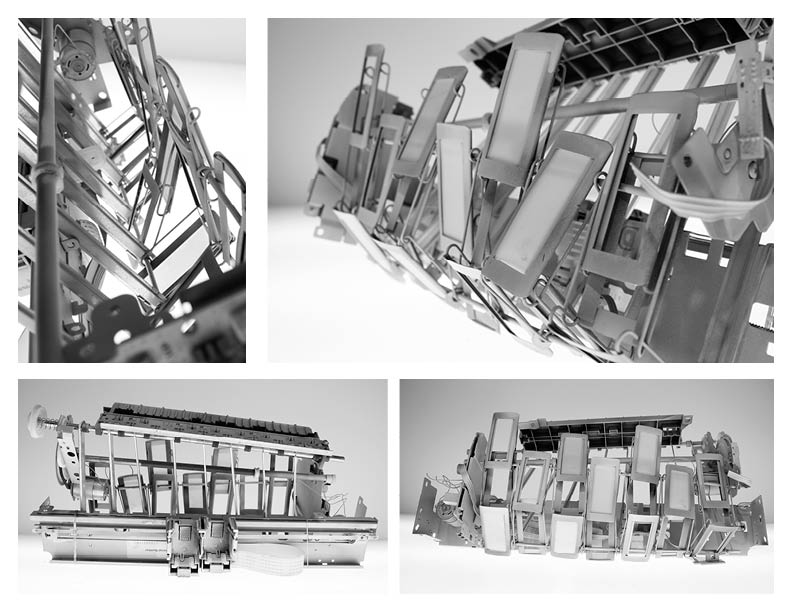Core Studio II | Pin up | BANK CITY
Click—> BANK CITY
My Bank Type: doppelgänger
I was very interested in the adaptive re-use of the old bank buildings for new purposes — everything from Duane Reeds to carpet stores and restaurants — but in particular, their relationship to actual banks nearby, or other building types that are or aren’t what they appear to be or not be. For there to be a doppelgänger there has to be an original, right? There can be no other without the self.
I’m in the process of exploring these ideas through these models. I was assigning new meaning to found objects, and exploring the structural/programmatic possibilities within these very conceptual spatial composites.
But these objects aren’t found objects anymore, not even at the beginning. They’re just a different set of materials. The materials I chose have had a history – meaning the limitations of the material extended to having to not only transform but reinterpret, or redefine. These materials just happen to have had lives before i defragmented them… so the reinterpretation of their meaning is actually the thing that’s redefined.
I dematerialized them (or attempted to, and still exploring notions of) and reprogrammed them. I was only really able to reprogram them after I dematerialized them. It’s harder to see something for what it really truly is, devoid of any meaning, than for what it isn’t. But as these objects colonize each other, they remodify themselves, and insodoing they completely reconfigure their context and as such, their context completely redefines them.
A very obvious analogy would be that in the same way that the Duane Reade acquired elements from the bank (such as vaults, marble tops, vestibules w/ empty shells where ATMS used to be, etc.) that it either embraced or neglected, the two typologies began to, had to, operate as one — culturally, socio economically.. You know, if you ask anyone in the West Village which is their favorite CVS, it’s the one on 14th and 8th ave, the old NY Savings Bank Building, but that branch actually loses a lot of customers because it isn’t what it is, it doesn’t look like what it is supposed to. The bank building will always be a bank building. The CVS will always be a CVS. Somehow, the unlikely synergy, the paring of a signifier to a new signified… it’s doing something. It’s doing something for them.
The question is: to what extent can notions of defragmenting and reprogramming be applied… Where, when and how does it reach the point that it no longer resembles anything at all? In other words, how can there be a doppelgänger of nothing? You’d have to ask: to what extent can the doppelgänger be retrofitted, remodified, reconfigured, reprogrammed from/by the self/original so that it loses all reference/meaning/definition from it, to the point that the interdependent relationship is rendered obsolete, and it is no longer defined by anything other than itself…. This would be the inception of something unfamiliar through the complete deterritorialization of something soo familiar.
Given all that, these models are banks.
There’s going to be a re-reasoning of what these ideas present through what the bank actually is. Or a re-reasoning and a re-reading of what the bank represents through what these ideas actually are.
>>#29: The 1% Gets All The Good Stuff
————-
2/19/12
“This makes so much sense. Especially in the context of the bank and how we defined it as some(thing)(action)(state) that is constantly defining/refining itself and being redefined. At it’s simplest level this is making the shift from an architecture of associations and images to one of perception, materiality and a fluid dialectic between individual (people)(events)(times) and environment (architectural/spatial, but also incorporating any other climates – natural, political, social….)
Doppelganger of nothingness? No, I think it is actually a doppelganger of shifts and interactions and instances. In a sense, a chameleon. Or a bogart. Like, it reads/is perceived/is felt or experienced as something different to everyone. It is not imaged as a “bank.”
–someone who got it.

















